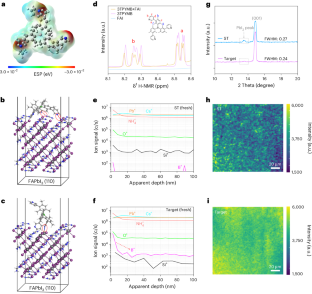In situ energetics modulation enables high-efficiency and stable inverted perovskite solar cells
IF 32.3
1区 物理与天体物理
Q1 OPTICS
引用次数: 0
Abstract
In contrast to conventional (n–i–p) perovskite solar cells (PSCs), inverted (p–i–n) PSCs offer enhanced stability and integrability with tandem solar cell architectures, which have garnered increasing interest. However, p–i–n cells suffer from energy level misalignment with transport layers, imbalanced transport of photo-generated electrons and holes, and significant defects with the perovskite films. Here we introduce tris(2,4,6-trimethyl-3-(pyridin-3-yl)phenyl)borane (3TPYMB), a nonionic n-type molecule that, through hydrogen bonding and Lewis acid–base reactions with perovskite surfaces or grain boundaries, enables in situ modulation of perovskite energetics, effectively mitigating the key challenges of p–i–n PSCs. The p–i–n PSCs incorporating 3TPYMB achieve a certified quasi-steady-state power conversion efficiency of 24.55 ± 0.33%, with a reverse scan efficiency of 25.58%. They also exhibit exceptional stability, with unencapsulated devices retaining 97.8% of their initial efficiency after 1,800 h of continuous operation at maximum power point under N2 atmosphere, 1 sun illumination and 60 °C conditions. The introduction of 3TPYMB, an n-type molecule into inverted perovskite solar cells, enables a power conversion efficiency of 25.6%, with devices maintaining up to 98% of the initial efficiency after 1,800 h of operation.


原位能量调节实现高效稳定的倒置过氧化物太阳能电池
与传统(n-i-p)过氧化物太阳能电池(PSCs)相比,倒置(p-i-n)过氧化物太阳能电池具有更高的稳定性和串联太阳能电池结构的可集成性,因此受到越来越多的关注。然而,p-i-n 电池存在能级与传输层不对齐、光生电子和空穴传输不平衡以及过氧化物薄膜存在重大缺陷等问题。在这里,我们引入了三(2,4,6-三甲基-3-(吡啶-3-基)苯基)硼烷(3TPYMB),这是一种非离子 n 型分子,通过与包晶表面或晶界发生氢键和路易斯酸碱反应,可实现对包晶能量的原位调节,从而有效缓解 pi-i-n PSCs 所面临的主要挑战。含有 3TPYMB 的 pi-n PSC 经认证的准稳态功率转换效率为 24.55 ± 0.33%,反向扫描效率为 25.58%。它们还表现出卓越的稳定性,在氮气环境、1 个太阳光照和 60 °C 条件下,未封装器件在最大功率点连续工作 1,800 小时后,仍能保持 97.8% 的初始效率。
本文章由计算机程序翻译,如有差异,请以英文原文为准。
求助全文
约1分钟内获得全文
求助全文
来源期刊

Nature Photonics
物理-光学
CiteScore
54.20
自引率
1.70%
发文量
158
审稿时长
12 months
期刊介绍:
Nature Photonics is a monthly journal dedicated to the scientific study and application of light, known as Photonics. It publishes top-quality, peer-reviewed research across all areas of light generation, manipulation, and detection.
The journal encompasses research into the fundamental properties of light and its interactions with matter, as well as the latest developments in optoelectronic devices and emerging photonics applications. Topics covered include lasers, LEDs, imaging, detectors, optoelectronic devices, quantum optics, biophotonics, optical data storage, spectroscopy, fiber optics, solar energy, displays, terahertz technology, nonlinear optics, plasmonics, nanophotonics, and X-rays.
In addition to research papers and review articles summarizing scientific findings in optoelectronics, Nature Photonics also features News and Views pieces and research highlights. It uniquely includes articles on the business aspects of the industry, such as technology commercialization and market analysis, offering a comprehensive perspective on the field.
 求助内容:
求助内容: 应助结果提醒方式:
应助结果提醒方式:


